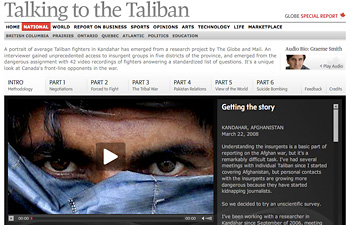Multimedia journalism is one of those terms often used to refer to a wide range of online content. Recently, I began a discussion with my students at the UBC Graduate School of Journalism to define exactly what the term means and how we can harness the many forms of online media to produce quality journalism.
We started by first asking what a multimedia story is not. After all, go to any news website and you are certain to see stories being told using a combination of media. But just because an online story has multimedia elements does not mean that it is a multimedia story.
By multimedia story, I mean a story that smoothly integrates video, text, still photos, audio and graphics. Usually, news websites fail to combine mediums in their stories, instead posting stand-alone text or video stories side by side. Often such stories are print or broadcast content that have been “repurposed” for the web. Repurposing is understandable, growing out of an economic need to make the most of the content by distributing it across several platforms.
But journalists need to understand that the Internet is not just another distribution channel. This is the starting point for multimedia journalism, defined by journalist and educator Jane Stevens as:
Some combination of text, still photographs, video clips, audio, graphics and interactivity presented on a website in a non-linear format in which the information in each medium is complementary, not redundant.
This means that journalists need to think on different levels as they conceive of a story and its treatment. It involves taking a multifaceted approach to a story and working out how best to tell it with the media available. The attraction for journalists is the ability to tell a story in multiple ways, making information accessible in ways that go beyond the standard news article in print.
Thinking Beyond Tools
Working in multimedia today is much easier than it was in the early days of online journalism 10 years ago, when journalists needed to have an intimate knowledge of HTML to use the web. Even textbooks produced just a few years ago devote chapters to HTML and CSS (cascading style sheets).
Today there are a plethora of tools to produce video, slideshows, maps and other multimedia works. Ten years ago, many of these features would have required programmers, but today they have become so simple that ordinary journalists can use them.
In the classroom, I’ve found that students are eager to tell their stories in text, photos, video and more. Sometimes, it is hard to rein in this enthusiasm. I try to remind them that our goal as journalists is not to give the audience everything.
One of the key roles of the journalist remains making editorial decisions on what is the most relevant and compelling information. What you leave out is an important as what you include. In one case, a student added stills from a presentation to explain a complex, technical issue. But without the commentary, the images were meaningless and confusing.
In any case, not all stories lend themselves to multimedia. Just because you can shoot video cheaply or produce an audio slideshow quickly, doesn’t mean you should. The best multimedia stories are multi-dimensional. They might include action that can be captured on video, or a process that can be illustrated with a graphic. Perhaps there is a strong emotional component that can be captured in a still photograph.
This requires that every journalist have some degree of multimedia literacy. At the very least, I expect my students to understand what kind of stories work best in what medium.
Making Practical Decisions
For this class, I shied away from just showing lots of examples of multimedia journalism, although I did point out the award-winning in-depth report on the Taliban by Canada’s national newspaper. Instead, we spent the time putting to practice these multimedia literacy skills.
For one exercise, we took a story idea from one student’s urban beat and broke it down into the different elements of the story. The idea focused on an art project in Vancouver that sought to educate children about the history of the city. We then discussed which medium was best suited to tell the different aspects of the story, using as our guide a cheat-sheet on multimedia story decisions developed by Mindy McAdams at the University of Florida.

One student suggested a photo gallery with drawings by the children alongside archive images of the city. Another proposed putting together an audio slideshow with photos of the children and clips of them talking about the project. Another idea was a timeline of key moments in Vancouver’s history. There was no shortage of ideas, but in each case, students had to explain why they picked a particular choice of medium.
McAdams’ cheat-sheet is a practical first step for journalists in legacy media seeking to explore the online world. Print reporters tend to default to telling stories in text, while TV reporters will default to video. Yet the new digital media landscape means that journalists should think about what might really be the best format for a story.
Multimedia literacy is rarely discussed in newsrooms, but journalism students of today should learn it in preparation for entering the newsrooms of tomorrow.
If you have good examples of multimedia journalism, please share them in the comments below.
Alfred Hermida is an online news pioneer and journalism educator. He is an assistant professor at the Graduate School of Journalism, the University of British Columbia, where he leads the integrated journalism program. He was a founding news editor of the BBC News website. He blogs at Reportr.net.
Photo of Mindy McAdams by William Couch via Flickr.


Check out http://www.windycitizen.com for a great example of citizen/real journalism.
We’re pretty proud of this multimedia package we produced to complement a series in print about the Dust Bowl migration to California in the 1930s.
http://www.modbee.com/outofthedust